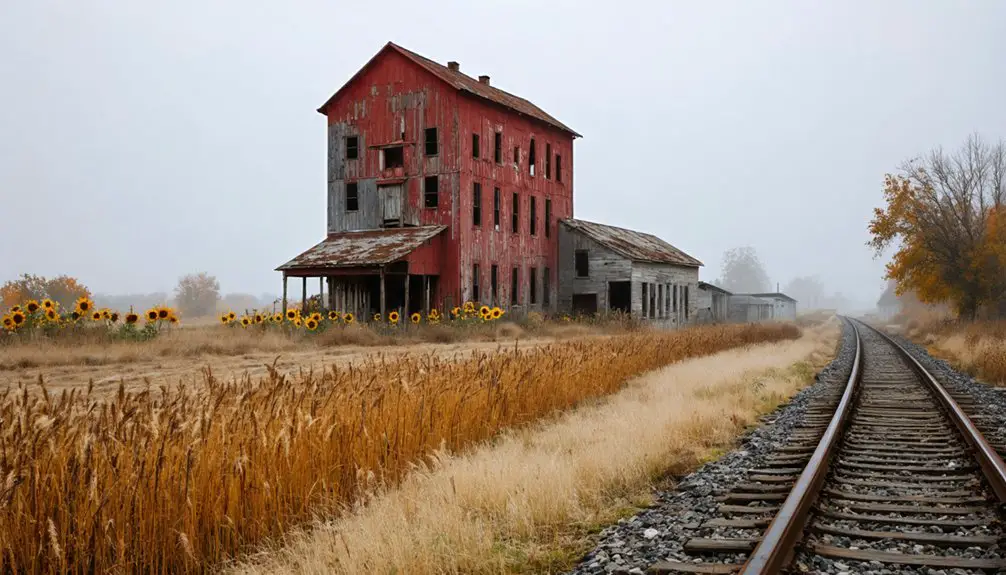You’ll discover Muskoda as a fascinating ghost town in Clay County, Minnesota, where prairie grasslands once supported a bustling railroad community. Its name comes from the Ojibwa word “Mashkode,” meaning meadow or grassland. The Northern Pacific Railroad established the town in the 1870s, bringing settlers, businesses, and agricultural prosperity. When the railroad relocated its tracks by 1930, Muskoda’s essential lifeline vanished. The town’s abandoned remnants tell a compelling story of Minnesota’s rural transformation.
Key Takeaways
- Muskoda was established along the Northern Pacific Railroad in Hawley Township during the 1870s but became abandoned by 1930.
- The town’s name comes from the Ojibwa word “Mashkode,” meaning meadow or grassland, reflecting Minnesota’s Native American heritage.
- Essential businesses included a post office, general store, grain elevator, and potato warehouse serving the local agricultural community.
- The town’s decline directly resulted from the Northern Pacific Railroad’s decision to relocate its tracks away from Muskoda.
- Today, Muskoda exists as a ghost town, exemplifying how railroad-dependent communities were vulnerable to transportation infrastructure changes.
Origins of the Ojibwa Name
The Ojibwa word “Mashkode,” meaning “a meadow or tract of grassland,” forms the linguistic foundation of Muskoda’s name. You’ll find this documented by Baraga, who traced the name’s origins through the rich tapestry of Minnesota’s indigenous heritage.
The name perfectly captures the expansive prairie landscape that characterizes the region, reflecting the deep connection between the Ojibwa language and the natural environment. Similar to the state’s name Mnisóta Makhóčhe, Muskoda’s name demonstrates how Native languages described the land’s features.
As one of Minnesota’s primary Native languages, Ojibwa has left an indelible mark on the state’s geography. While European settlers often modified the original pronunciations, leading to the current spelling of Muskoda, the cultural significance remains intact.
Through this name, you’re connected to the area’s original inhabitants and their profound understanding of the land they called home. The town’s location along the Northern Pacific Railroad line shaped its early development and growth.
Railroad’s Role in Early Settlement
While many Minnesota towns emerged organically, Muskoda’s birth and eventual demise were inextricably linked to the Northern Pacific Railroad. As railroad expansion pushed through Clay County in the 1870s, you’d have found Muskoda strategically positioned along the line in section 7 of Hawley Township.
The railroad’s presence sparked rapid community development, bringing essential services that defined frontier life. You could’ve visited the town’s post office, general store, grain elevator, and potato warehouse – all crucial facilities that served the surrounding agricultural region. The development followed a pattern similar to other railroad towns, where the Northern Pacific shops became the first manufacturing establishments in their respective communities.
The Northern Pacific’s influence was so profound that when construction began in 1870, it shaped not just Muskoda’s location but its very destiny. Large land grants accompanied the railroad’s development, fundamentally altering settlement patterns and creating the framework for this prairie community’s brief but significant existence.
Agricultural Heritage and Commerce
During its heyday, Muskoda’s agricultural prowess stemmed from the rich soils of Clay County, where pioneering farmers cultivated diverse crops like wheat, corn, oats, and alfalfa.
You’ll find that the area’s crop evolution mirrored Minnesota’s broader agricultural transformation, shifting from early Native American farming techniques to mechanized operations that defined the bonanza farm era.
The region’s Class II soils supported robust wheat production, and you’d have seen local farmers adapting their farming techniques as new machinery like steel-blade plows and reapers arrived.
Thanks to the railroad’s presence, Muskoda’s farmers could ship their harvest to Minneapolis markets, contributing to Minnesota’s reputation as a leading wheat producer by 1890.
The agricultural commerce that flourished here reflected the enterprising spirit of its farming community.
Early settlers in the area maintained subsistence farming operations, growing just enough food to feed their families and engage in local trade.
Life in a Prairie Community
Living in Muskoda meant embracing the rhythms of prairie life, where residents built their community around the Northern Pacific Railroad line and the rich grasslands that gave the town its Ojibwa name.
The prairie lifestyle demanded community resilience as settlers faced harsh Midwestern seasons while establishing their homes and businesses. The area’s connection to Glacial Lake Agassiz shaped the unique delta landscape that early residents called home.
Your daily experience in Muskoda would have included:
- Gathering at the general store to exchange news and supplies, making it a hub of community life
- Relying on the post office for crucial connections to the outside world
- Working alongside neighbors in agricultural pursuits, from grain storage to potato processing
- Adapting to the challenges of prairie weather, from scorching summers to bitter winters
These shared experiences forged strong bonds among Muskoda’s residents until changing times led to the town’s eventual abandonment.
The Great Railway Relocation
The strong community bonds that defined Muskoda’s prairie life would soon face their greatest test with the Great Northern Railway‘s strategic realignment in the late 19th century.
As you’d witness the railway expansion transform the landscape, you’d understand how it reshaped not just the physical terrain but the very fabric of community life.
The Great Northern’s decisions during this period reflected broader changes sweeping across Minnesota. Under the leadership of James J. Hill, the railway’s aggressive expansion and development strategies would reshape the economic destiny of numerous small towns.
As Minnesota evolved, the Great Northern Railway’s choices echoed the transformative spirit reshaping the state’s destiny.
The railway actively recruited settlers through European newspaper ads to populate towns along its routes.
You’d see how the railway’s strategic placement of new infrastructure and industry locations directly impacted small towns like Muskoda.
While some communities flourished with the railway’s support, others faced devastating consequences when routes changed.
The community impact went beyond mere transportation – it determined which towns would thrive and which would fade into history, marking a pivotal moment in Muskoda’s story.
From Bustling Town to Abandonment
You’ll find that Muskoda’s descent into ghost town status began in earnest when the Northern Pacific Railroad relocated its line, severing the town’s essential transportation link.
While the community had thrived as an agricultural hub with its grain elevator and potato warehouse serving local farmers, the loss of rail access made it increasingly difficult to transport goods to market.
Today, the former town site sits about half a mile off the relocated railway tracks, showcasing how transportation changes can reshape communities.
The name Muskoda stems from the Ojibwa word Mashkode, which translates to a meadow or grassland area.
The town’s businesses, including its general store and post office which closed in 1930, gradually shuttered as residents moved away in search of better economic opportunities.
Railroad Relocation Sealed Fate
While Muskoda once thrived as a bustling railroad town along the Northern Pacific line, its fate was sealed in 1909 when the railroad company relocated its tracks to follow a more gradual grade.
The railroad impact was devastating for this small community, as the new tracks were positioned half a mile away from town, effectively cutting off its lifeblood of commerce and connectivity. The relocation mirrored the experience of other towns like Muscoda, where railroad track placement determined community survival.
The community decline following the railroad’s departure was marked by:
- The closure of essential businesses including the general store
- The eventual shutdown of the potato warehouse and grain elevator
- The loss of regular freight and passenger service
- The post office’s closure in 1930, marking the end of official services
Today, you’ll find little evidence of Muskoda’s once-vibrant community, as it stands as a monument to how railroad decisions could make or break frontier towns.
Agricultural Hub Goes Silent
Before Muskoda’s decline as a thriving agricultural center, its fertile lands supported diverse farming operations that ranged from wheat production to specialty crops like potatoes.
You’d find farmers adapting their crop preservation methods to store cucumbers, melons, and squash for the long Minnesota winters. The town’s infrastructure, including its potato warehouse and grain elevator, served the surrounding agricultural community well.
Early settlement patterns revealed the determination of these prairie farmers, who built homes from sod while establishing their operations.
As market pressures mounted, many farmers faced mounting debts from railroad fees and equipment costs. Despite diversifying their crops and exploring alternatives like dairy farming, Muskoda’s agricultural community couldn’t sustain itself against economic challenges.
The once-bustling hub of farming activity gradually fell silent as families sought opportunities elsewhere.
Legacy in Minnesota’s Rural History

As one of Minnesota’s most evocative ghost towns, Muskoda’s legacy persists through its profound impact on the state’s rural development narrative.
The town’s story embodies rural resilience and community nostalgia, serving as a powerful reminder of how transportation changes can reshape local destinies.
You’ll find Muskoda’s enduring influence reflected in these key historical lessons:
- The town’s Ojibwa-derived name preserves Indigenous cultural connections
- Its rise and fall mirror countless other railroad-dependent communities
- The town’s agricultural heritage shaped regional farming practices
- Its documented history helps modern communities plan for sustainability
Today, while physical structures have vanished, Muskoda’s story continues to educate future generations about the delicate balance between progress and preservation in rural America.
Frequently Asked Questions
What Was the Peak Population of Muskoda During Its Most Prosperous Years?
Like a ghost vanishing in the mist, you’ll find that no exact peak population figures exist for Muskoda’s glory days before its economic decline, though population growth peaked prior to 1909.
Were There Any Schools or Churches Established in Muskoda?
You won’t find clear records of school history or church influence in Muskoda. While small towns typically had these institutions, historical documents don’t confirm their existence in this community.
What Natural Disasters or Severe Weather Events Affected Muskoda’s History?
You won’t find documented evidence of specific flood impacts or storm damage affecting Muskoda’s history. While Minnesota faces various weather challenges, no natural disasters are officially recorded for this community.
Did Any Notable Historical Figures Have Connections to Muskoda?
Like searching for footprints in shifting sand, you won’t find any documented historical connections or notable residents who left their mark on Muskoda’s brief existence as a railroad town.
What Happened to the Original Buildings and Structures After Abandonment?
You’ll find most abandoned structures deteriorated naturally over time without historical preservation efforts. The buildings crumbled due to weather exposure, lack of maintenance, and nature’s reclamation of the settlement’s remains.
References
- https://en.wikipedia.org/wiki/Muskoda
- https://kids.kiddle.co/Muskoda
- https://en-academic.com/dic.nsf/enwiki/7477031
- https://blueearthcountyhistory.com/2020/09/23/ghost-towns-in-blue-earth-county/
- https://www.wikiwand.com/en/articles/Muskoda
- https://alchetron.com/Muskoda
- https://en.wikipedia.org/wiki/List_of_Minnesota_placenames_of_Native_American_origin
- https://themetropole.blog/2020/10/13/where-the-waters-reflect-the-clouds-examining-minnesotas-indigenous-history/
- http://wikimapia.org/14826608/Muskoda-Minnesota-Ghost-Town
- http://www.crowwinghistory.org/nprr.html



